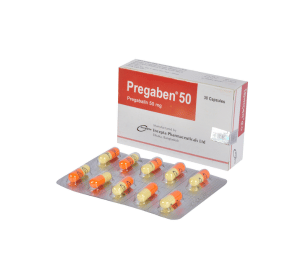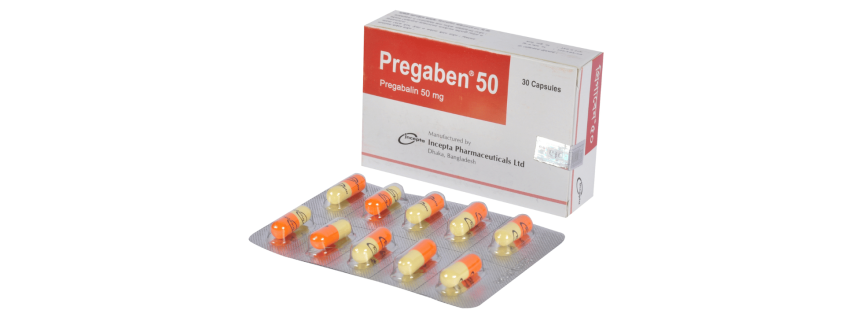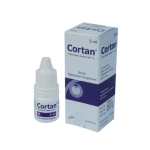Pregaben(Pregabalin)

Therapeutic Group: Drugs of Nervous System
Presentation
Pregaben 25: Each capsule contains Pregabalin INN 25 mg.
Pregaben 50: Each capsule contains Pregabalin INN 50 mg.
Pregaben 75: Each capsule contains Pregabalin INN 75 mg.
Pregaben Oral Solution: Each ml oral solution contains Pregabalin INN 20 mg
Description
Pregabalin is a structural derivative of gamma-amino-butyric acid (GABA). It does not bind directly to GABAA, GABAB, or benzodiazepine receptors. It binds with high affinity to the alpha 2-delta site (an auxilliary subunit of voltage-gated calcium channels) in central nervous system tissues. Oral bioavailability of Pregabalin is 90%. Pregabalin is eliminated largely by renal excretion, and has an elimination half-life of about 6 hours. Pregabalin can be taken with or without food.
Indications
Neuralgia: (a) pain from diabetic neuropathy, (b) post herpetic neuralgia
Partial seizure / epilepsy: Pregabalin is also indicated as adjunctive therapy for adult patients with partial onset seizures.
Dosage & Administration
Neuropathic pain
Initially 150 mg daily in 2 divided doses, increased if necessary after 3-7 days to 300 mg daily in 2 divided
doses, increased further if necessary after 7 days to maximum 600 mg daily in 2 divided doses.
Post herpetic neuralgia
The recommended dose of pregabalin is 75 to 150 mg two times a day. Dosing should begin at 75 mg two
times a day and may be increased to 300 mg/day within 1 week based on efficacy and tolerability.
Fibromyalgia
The recommended dose of pregabalin for fibromyalgia is 300 to 450 mg daily in 2 divided doses.
Epilepsy
Initially 150 mg daily in 2 divided doses, increased if necessary after 7 days to 300 mg in 2 divided doses,
increased further if necessary after 7 days to maximum 600 mg daily in 2 divided doses.
Generalised anxiety disorder
Initially 150 mg daily in 2 divided doses, increased if necessary after 7 days to 300 mg in 2 divided doses,
increased further if necessary after 7 days to maximum 600 mg daily in 2 divided doses.
Neuropathic pain associated with spinal cord injury
The recommended dose is 150 to 600 mg /day. Initially 75 mg b.i.d; may be increased to 150 mg b.i.d (300
mg /day) within 1 week . Maximum 300 mg b.i.d (600 mg/day)
Side Effects
Pregabalin is well tolerated but a few side effects like dizziness, somnolence and blurred vision may occur.
Precautions
Abrupt or rapid discontinuation of Pregabalin may produce some symptoms including insomnia, nausea, headache and diarrhoea. So Pregabalin should be tapered gradually over a minimum of 1 week rather than discontinued abruptly. Pregabalin treatment may associate with creatine kinase elevations. It should be discontinued if myopathy is diagnosed or suspected or if markedly elevated creatine kinase levels occur.
Use in Pregnancy & Lactation
Pregnancy: Pregabalin is a pregnancy category-C drug. It should be used during pregnancy only if the potential benefit justifies the potential risk to the fetus.
Lactation: Pregabalin may be secreted through the breast milk like other drugs, so it should be used in nursing women only if the benefits clearly overweigh the risks.
Pediatric Use
The safety and efficacy of Pregabalin in pediatric patients have not been established.
Drug Interaction
The extent of Pregabalin absorption is unaffected by gabapentin co-administration. It does not interact with other antiepileptic agents or oral contraceptive preparations.
Over Dose
Overdosage of up to 8000 mg has been reported. The symptoms consist of dizziness, somnolence, blurred vision and mild diarrhoea. Pregabalin can be removed by emesis or gastric lavage.
Commercial Pack
Pregaben 25: Each box containing 3 blister strips of 10 capsules.
Pregaben 50: Each box containing 3 blister strips of 10 capsules.
Pregaben 75: Each box containing 3 blister strips of 10 capsules.
Pregaben Oral Solution: Each bottle contains 100 ml of Pregabalin oral solution.



